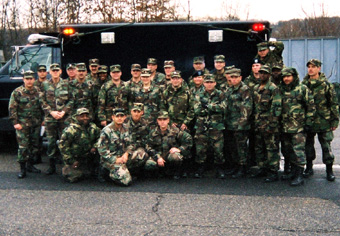 |
But across the Hudson River, alongside the major arteries that link New Jersey and Manhattan, and in a nondescript North Jersey park, the unsung heroes of the 3rd and 21st Civil Support Teams (CST) played a critical in role in protecting against a New Year’s Eve catastrophe. A 28-member National Guard Weapons of Mass Destruction (WMD) anti-terrorism force monitored the environment at strategic locations and was poised to respond to any emergency.
The CST concept first was developed in the late 1990s and nearly every state in the nation has a team equipped to respond to attacks or incidents involving chemical, biological, or radiological weapons. Thirty-two states have CST’s consisting of 22 full-time guardsmen; the remaining teams are manned by 22 “part-time”, traditional guardsmen.
The teams’ primary mission is to identify the hazardous substance(s) used in a terrorist attack or WOMD (weapons of mass destruction) incident and work in cooperation with other emergency operations personnel to neutralize the threat. Each CST has personnel who specialize in substance monitoring, communications, decontamination, and field laboratory identification.
CST’s employ two large, expensive pieces of equipment: a Mobile Analytical Laboratory System for field analysis of chemical or biological agents, and a Unified Command Suite used to communicate with local emergency responders as well as federal agencies such as the Defense Threat Reduction Agency and the Army's Soldier Biological Chemical Command.
During most of the year, CST personnel hone their skills by extremely realistic and demanding training to ensure that when the “balloon goes up” they are fully prepared and equipped to respond effectively.
About a week prior to New Year’s Eve, the “balloon” was rising in the New York Metropolitan area. United States intelligence sources had received credible information of a possible terrorist attack using chemical and/or biological weapons in the New York City and Northern New Jersey area. Several days earlier, the National Security Threat Warning System rose from level yellow (elevated) to level orange (high). Specific targets in New York City area had been identified by intelligence sources.
![]()

On Mar. 9, the Department of Defense announced its plans to place one of 12 new Weapons of Mass Destruction Civil Support Teams (WMD CST) in New Jersey.
The 22-member team will be trained to detect and respond to chemical, biological and nuclear weapons. The team will provide analysis, medical and technical advice, and prepare for larger-scale state and federal response. The CST’s equipment will include a mobile lab to assess chemical and biological agents, and a specialized communications system to enable first responders, health experts and scientists analyze and react to the threat.

